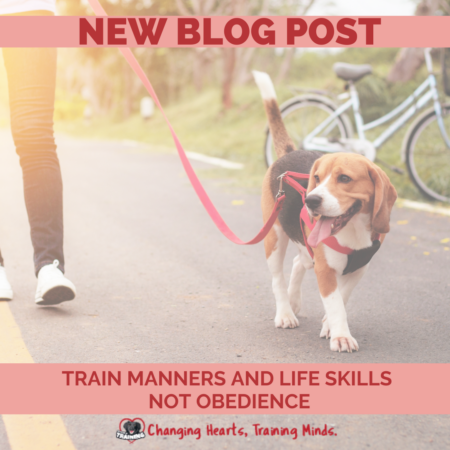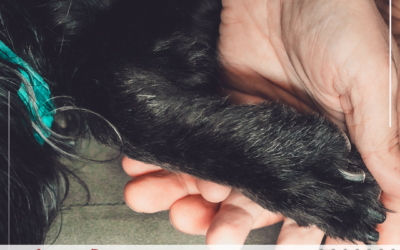As someone who focuses on fear cases, I have a disproportionate amount of people who view their dog’s fear issues as behavior “problems” that need “fixing” instead of recognizing that fear is not disobedience. The more I was thinking about this, the more I realized that this is another example of dog training being unregulated and the continued damage that is causing to dogs and their owners. Unqualified “trainers” promising to “fix” dogs who are afraid of people or other dogs by shocking them, because sure, when they get shocked, they stop barking. So they “fixed” it, right? Nope. It’s done nothing to help the dog feel better around the thing they were scared of, and it’s now made that scary thing even more scary because now it predicts pain. Behavior suppression is not behavior modification.
In addition to unqualified “trainers” making promises of quick fixes for long-term behavior concerns, there’s a societal issue where we judge people who have dogs who aren’t fully able to handle the situations we put them in. So dogs bark, lunge, growl, cower, or otherwise communicate they’re not comfortable and passersby make snide comments like “train your dog!” or “wow, he’s out of control!” Our society is full of people who shame others for having dogs who behave like dogs, because of this dominance construct where we expect owners to “control” their dogs.
We’ve created a society where we expect dogs to act like computers who are perfectly programmed, respond with 100% accuracy and are not susceptible to environmental changes, life experiences, genetics and plenty more. Not only is this a completely unreasonable expectation for any living creature, to perform 100% of the time, but it puts an enormous strain on the relationship of the human and dog. If your dog isn’t a robot, people give you dirty looks, laugh or try to embarrass or shame you with comments.
Do we train children with obedience? No. Do we expect human children to be perfectly behaved 100% of them time? No. Do we expect them to never have a tantrum when they’re told no, are tired, or cry because they’re afraid at the doctor’s office? Of course not. Do we shame parents for a crying child? No. Do we offer unsolicited parenting advice while their child is face down in the middle of the grocery store? No, (and if you do you probably shouldn’t.) We teach children life skills be integrated into our adult world, giving them tools for communication and understanding when they might just need a break. We teach children manners, not obedience.
This expectation that dogs should have robotic performance for commands is a construct left over from the now debunked dominance theory. When dominance theory was en vogue, people wanted to prove they were in charge of their dog, so barked commands and the dog was expected to perform. It was a relationship based on fear, not trust and love. Do what I ask or be punished. Not, do what I ask because you are opting in and this is a cooperative relationship.
But here’s the thing, for most pet dogs, there’s really only a handful of cues (I prefer that term to commands) that are really, really important for most owners. Is it life or death if your dog sits 100% of the time when you ask them? Nope, not usually.
So, wait, I’m a trainer and I’m saying not to do training? Not exactly. What I’m saying is there are more important things than robotic obedience. Remember, you opted to bring this animal of a different species into your life. It’s not reasonable to expect them to not behave like the animal they are. Let’s focus on manners not obedience. Cooperation instead of intimidation. Collaborative not coercive. Cues over commands.
Use food, and lots of it, not just praise. Your dog doesn’t want to please you, any more than you go to work for your boss to tell you that you’re doing a great job. You go to work to get a paycheck. Your dog is no different. Food is not bribery – it’s motivation for your dog to work and to figure out what we’re asking him to do.
More important than any basic cues or obedience skills you might think your dog needs are these life skills.
- Let’s focus on teaching our dogs to feel safe in the world – with people, dogs, novelty and sounds.
- Let’s focus on cooperative care, so vet and grooming isn’t stressful.
- Let’s teach dogs to like being alone and confined, in case they need to be on medical rest for a period of time.
- Let’s teach dogs to be comfortable wearing a recovery collar or other gear they may need at some point in their life, like a muzzle.
- Let’s focus on a handful of important skills that will help them navigate our world comfortably.
- Let’s teach them they can be dogs and do dog things, without fear of scary or painful punishment.
- And, let’s teach them they can always trust us to keep them safe and help them if we put them into a situation that is too much for them to handle.
What are my top basic cues that I really encourage clients to train? There’s three, because they are potentially life-saving, in my opinion.
- Recall – We want to know with as much certainty as possible that when we call our dog, they will come to us. If your dog suddenly slips out of their collar or harness, will they reliably come back?
- Leave It – Dogs love to pick up gross things and they don’t have the foresight to know those things could make them very sick or be life threatening. You want to know if your dog is about to pick up a dead rat on the street, that he will choose to leave it if you ask him to, because that rat likely was killed with rat poison, which can also kill your dog.
- Stay – In some cases, like if your dog crosses a street alone, asking them to stay could be a life saving skill.
Everything else is icing on the cake. Now hear me out, before you send me hate mail or leave angry comments.
This doesn’t mean I want dogs dragging their owners down the street, causing rotator cuff tears. But, it does mean that just because we opt to do some loose leash walking training that forced march, militaristic, heeling walks should not be the norm. We can teach your dog to walk nicely on a leash when needed, but they still need plenty of leash walks that are on long lines and they’re allowed to sniff and explore. And really, your dog can walk on a loose leash without being in a heel. It’s OK if they get out in front of you. Manners, not obedience.
We can teach polite greetings if we have a dog who likes to jump, and we’re afraid he might knock grandma or the kids over, but then maybe we add in an invitation cue, so that if jumping to greet is allowed with some people, we still let the dog enjoy jumping to greet when it’s safe to do so. Manners, not obedience.
Let’s work together to help dogs feel safe, to learn we are listening to them, to trust we won’t put them in situations they can’t handle and that we won’t make them sit for every little morsel of food they ever get. You can schedule a session so we can review things one-on-one and come up with a plan for you and your dog.
Happy training!
![]()




